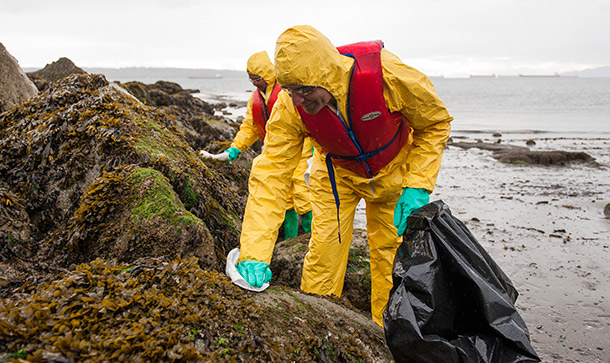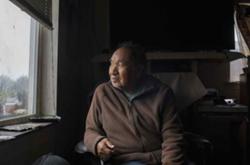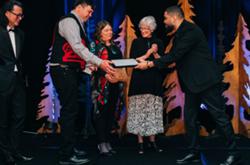Late Saturday afternoon, Transport Canada officially cleared the MV Marathassa to leave Canadian waters, weeks after the ship spilled an undetermined amount of fuel into Burrard Inlet.
As it exits the Salish Sea, the bulk carrier leaves angry mayors, a combative coast guard, a distrustful public and many, many questions in its wake. Here are four things we don't know -- and may never know -- about what happened in English Bay.
1. What is the total spill volume?
In his first press conference after the spill, Cmdr. Roger Girouard of the Canadian Coast Guard stated the volume of the spill was 2,700 litres. He reiterated this point during subsequent media appearances, and Industry Minister James Moore echoed his comments.
Vancouver city manager Penny Ballem disputes the claim. In a recent presentation to Vancouver's city council, she pegged the real volume somewhere between 3,000 and 5,000 litres.
Then there's the amount recovered. The day after the spill, Cmdr. Girouard reported cleanup crews had recovered about 1,400 litres of fuel. A few days later, Coast Guard Commissioner Jody Thomas said cleanup crews recovered 80 per cent of fuel spilled within 36 hours.
According to the president of a B.C. oil spill prevention and response planning firm, recovering between 10 and 15 per cent of conventional oil spilled in seawater is a "best case" scenario. Bunker C fuel -- the product spilled in English Bay -- is not conventional: it is denser, more viscous and heavier than conventional crude. Unlike conventional oil, bunker C fuel is not certain to float nor does it weather and dissolve as easily.
On average only five to 10 per cent of the bunker C fuel will evaporate within 24 hours. Instead it breaks into tarballs and settles lower in the water column -- sometimes as far as one to three metres below the surface.
If the federal government's figures are correct, the coast guard should have recovered 2,200 litres of spilled oil in the first 36 hours -- an 800 litre difference. This is possible, but unlikely given past precedent of what usually constitutes a "best case" cleanup. If total spill volumes are incorrect -- as Ballem and others suggest -- there remains even more unaccounted oil.
2. How would the shuttered Kitsilano Coast Guard station have responded?
In 2013, the federal government closed the Kitsilano Coast Guard station, consolidating operations with a station in Delta, B.C. Both the City of Vancouver and the province of B.C. publicly objected to the closure, citing its key role in oil spill and disaster response efforts.
At the time, Mayor Gregor Robertson called the station one of the most important public safety resources serving one of North America's busiest harbours. "In the event of major freighter, cruise ship, or aviation emergency, we remain very concerned that the Kitsilano closure will put many additional lives in danger," he said.
Both Cmdr. Girouard and Minister Moore claim the Kitsilano Coast Guard base would have made no difference in the cleanup of this spill. Girouard said the station was never staffed with environmental response experts, and would not have been called to the scene. He said the station had less than 100 metres of oil-absorbing boom, and that they were likely too old to be useful. Again, Moore echoed these comments.
Retired Coast Guard captain Tony Toxopeus, who served at the base, disagrees. So does Mike Cotter, general manager of the Jericho Sailing Centre, located next door to the shuttered station. In a local radio interview, Captain Toxopeus confirmed the Kits station had two ships (a pollution response vehicle and an Osprey cutter), along with oil spill response equipment and staff trained in pollution response.
We now know it took the coast guard more than three hours to send a ship to investigate, a further four hours to set up an absorbent boom and a total of 12 hours to encircle the Marathassa in containment boom. In an open letter to Minister Moore, Mr. Cotter said: "Had the Kitsilano Coast Guard station remained open, the Osprey could have been on scene within 10 minutes in direct contact with the boater who originally reported the spill just after 5 p.m. on April 8. Her crew would've assessed the scene... and commenced spill containment within an hour of the report."
3. Who is responsible for monitoring long-term impacts?
To be clear, the Burrard Inlet and the Salish Sea are not pristine waterways. E. coli contamination regularly closes local beaches to swimming in the summer, and the inlet hosts a working port. Still, Vancouver beaches attract millions of people every year, and many fish its waters for recreation or subsistence.
A week after the spill, Fisheries and Oceans Canada banned shellfish and groundfish harvesting in Burrard Inlet, citing concerns about the Marathassa spill. DFO calls the closure a precaution, and offers no indication of when the fisheries may reopen.
While the Marathassa spill was minor, toxins from bunker C fuel can stick around for a long time. A study done by U.S. Department of Fisheries scientists on a 2007 bunker C fuel spill in San Francisco harbour found the spill had decimated local herring stocks and left surviving fish with extensive birth defects and short life spans. This persisted for three years after the spill.
But Vancouver's waters are different. According to Dr. Peter Ross, director of the Vancouver Aquarium's ocean pollution research program, there's no baseline data for English Bay's waters, nor is there a cohesive long-term monitoring program. Both of these deficiencies make it hard to measure long-term impacts.
Since coastal waters fall under the purview of the federal government, it should be the responsibility of the DFO to monitor fallout from the spill. But millions of dollars in cuts have closed monitoring programs and left at least 50 scientists out of work. This includes Dr. Ross, who ran a marine toxicology program through DFO. It no longer exists.
The Vancouver Aquarium, the City of Vancouver and the DFO have all collected water samples independently following the spill. Unfortunately, as Dr. Ross says, "There is no official clarity around who is to monitor the effects of a spill."
4. What would Kinder Morgan do differently?
As the National Energy Board considers approval of the Kinder Morgan Trans Mountain tanker and pipeline expansion, both parties could be learning from the Marathassa case to ensure future spill preparedness and response is truly "world-class."
Instead, Kinder Morgan refuses to publicly reveal any of its oil spill cleanup plans for Burrard Inlet. This leaves all governments in the dark about what might happen if the new twinned pipeline ruptures again, or if one of the hundreds of new tankers -- 40,000 tonnes larger than the Marathassa -- leaks diluted bitumen into English Bay.
For all the questions that remain, one thing is crystal clear after the Marathassa spill: we can, and must, do better. ![]()
Read more: Environment















Tyee Commenting Guidelines
Comments that violate guidelines risk being deleted, and violations may result in a temporary or permanent user ban. Maintain the spirit of good conversation to stay in the discussion.
*Please note The Tyee is not a forum for spreading misinformation about COVID-19, denying its existence or minimizing its risk to public health.
Do:
Do not: